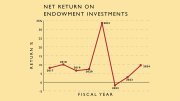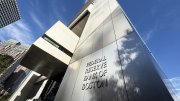During the fiscal year ended June 30, 2024—a year of campus tumult, an overturned presidency, and speculation about the resulting effects on donor support—Harvard’s finances showed some strains, but no dramatic change in the University’s circumstances. Revenues and expenses both continued to rise, again yielding an operating surplus (extending a record now dating more than a decade)—but narrower than in fiscal 2023. The investment return on endowment assets rose smartly, increasing the endowment’s value overall: key metrics, since distributions from the endowment remain Harvard’s largest source of operating revenues. Highlights include:
• a $45-million operating surplus, down from $186 million in fiscal 2023, as revenues increased 6 percent, to $6.5 billion, and expenses 9 percent to $6.4 billion (all figures are rounded). The latter include unspecified sums for the costs of contending with protests and augmenting security, complying with information requests from Congress and the U.S. Department of Education, and responding to lawsuits—all prompted by fallout from the October 7, 2023, Hamas attack on Israel and the ensuing war.
• Harvard Management Company (HMC) realizing a net 9.6 percent rate of return on endowment investments, up from the 2.9 percent reported in the prior year.
• the aggregate endowment investment gains of $4.5 billion, reduced by the $2.4 billion distributed to Harvard’s operating budget (in turn partially offset by $368 million in gifts for endowment, plus other changes), increasing the endowment’s value by $2.5 billion, to $53.2 billion as of June 30, 2024, up 4.9 percent from $50.7 billion one year earlier.
In their letter in the annual financial report, published October 17, vice president for finance Ritu Kalra, the chief financial officer, and University treasurer Timothy R. Barakett observed, “We live in a world of persistent uncertainty, underpinned by economic volatility and geopolitical unrest” and signaled concern about “pressures on our operating performance” as growth in expenses exceeded growth in revenue for a second year. The surplus was “smaller…than had been budgeted,” pointing to “the need to improve our financial capacity.”
Harvard’s operating revenue increased 6 percent during fiscal 2024, to $6.5 billion from $6.1 billion in the prior year, as endowment distributions (37 percent of the total) rose from $2.2 billion to $2.4 billion: about 9 percent. The increase reflects the 4.5 percent increase in the distribution per endowment unit owned by schools, approved by the Corporation for fiscal 2024, plus the increase in the number of units owned (from gifts). But note: for fiscal 2025, a smaller 2.5 percent increase is authorized. Net student income (21 percent of the total, reported after financial aid) increased $51 million, to $1.4 billion: up 4 percent. Degree programs (undergraduate and graduate) yielded just 2 percent more revenue. The real standout again was executive and continuing education, which rose 8 percent, to $587 million. Sponsored support for research (16 percent of revenue) decreased by $13 million.
Gifts for current use (8 percent of revenue) increased $42 million, to $528 million (9 percent). This figure merits interpretation. The balance of pledges receivable for current-use gifts declined $68 million (from $953 million at the end of fiscal 2023 to $885 million at the end of fiscal 2024); the year-end balance reflects the net of prior pledges actually paid during the current year and new pledges received. Payments on prior-year pledges increase the current-use gifts reported in fiscal 2024; they apparently include significant payments by Hansjörg Wyss, M.B.A. ’65, who in 2023 pledged $350 million in support of the eponymous biological research institute (increasing the year-end 2023 pledge balance), and Michael R. Bloomberg, M.B.A. ’66, LL.D. ’14, who has been supporting an urban leadership training program. The year-end 2024 receivables balance was increased by commitments such as some of the College class of 1994’s $200 million’s worth of thirtieth reunion giving. So the reported current-year giving reflects multiple years of philanthropy, suggesting that there was at least some effect on actual fiscal 2024 donations, stemming from the campus turmoil.
Finally, other revenue (18 percent) increased $91 million, to $883 million—about 11 percent—mainly due to increases in royalties from licensing intellectual property.
Turning to expenses, Harvard spent $6.4 billion on operations in fiscal 2024, up a half-billion dollars from the prior year: 9 percent. Salaries and wages rose to $2.6 billion from $2.4 billion, or 9 percent. More than half that increase reflects merit increases and other adjustments for nonunionized employees, and to negotiated contracts for unionized staff. The rest stems from growth in the workforce—principally filling positions that remained vacant following the pandemic. Employee benefits spending increased $62 million, to $690 million (up 10 percent)—closely aligned with the increase in salaries and wages. Other notably higher expenses reflected the resumption of full University operations and increased in-person use of facilities. Space costs rose $78 million (8 percent), as more people worked more hours on campus, and as energy prices increased. Spending also rose markedly for “significant investments in information technology, with a focus on enhancing security, integrating artificial intelligence, and developing advanced cross-campus learning platforms.”
The 9.6 percent endowment return (net of investment expenses) brings the annualized rate of return during the past seven years (the period of HMC’s current management, structure, and strategies) to 9.3 percent, according to the financial report. HMC’s public equity and hedge fund assets performed strongly—and helped bolster performance relative to most peers (many of which deemphasize public securities and more heavily weight private-equity holdings, which lagged stock market returns for the second year in a row—the case for HMC, too).
Growth in expenses outstripping growth in revenue “is not a long-run sustainable path,” Kalra noted in a Q&A with the Harvard Gazette. (Some units, like the Medical School, are reported to be on the verge of renewed budget deficits.) But behind the numbers, she added, are investments “intended to foster future growth” and “enable types of research that were unimaginable just a decade ago.” All that implies “the need for prudence going forward.” Barakett added, “The University has investments it must make in the near future,” in areas from financial aid (attending the College is free for students from families earning less than $85,000 a year, but competing institutions have raised that threshold considerably) to sustainability as Harvard transforms the sources and use of energy across campus to meet its goals and commitments. The latter will be a significant expense, alongside continuing ones like the multi-hundred-million-dollar renewal of Eliot House, now on the horizon, and Kirkland after that.
“In our planning for the years ahead,” he concluded, “we must create the financial capacity to make room for these investments.” That may be no small task in the current political and economic environment, where the talk about sharply higher excise taxes on the largest endowments gained new currency after the U.S. elections on November 5.
Read a full report at harvardmag.com/financial-report-24.









